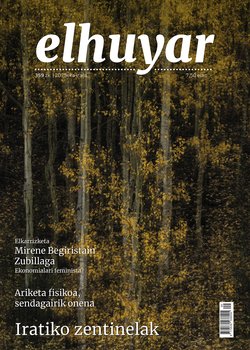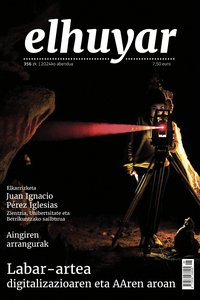On the trail of wolves
We are located in the lands of Álava, an environment where wolves come and go. Félix Martínez and Jorge Echegaray are looking for clues that denounce the presence of wolves.
The wolf is a difficult animal to detect. It moves in very large areas, which makes research difficult. The difficulties are exacerbated in environments that are humanised like Álava, in territories with a small population of wolves.
Jorge Echegaray, CSIC researcher It should be noted that we are on the northeastern border of the territory of the wolf in the Iberian Peninsula. As a result, the difficulties are even greater."
Although it is difficult, the investigation of the wolf is not impossible, since the animals leave traces in the mountain that are studied by those who investigate the movements of animals of the species Canis lupus. Specifically, they search and analyze the faeces of wolves. in the early 2000s, Echegaray and Martinez began searching for wolf remains. They have several defined paths that follow the same paths in all the exits.
Jorge Echegaray, CSIC researcher: "We do field sampling in environments where wolves are believed to be attacking and where cattle are severely damaged. Routes are chosen where it can be easy to find clues. For this, the characteristics of the routes are taken into account. Mountain paths, crossings, and, in general, environments where the wolf moves easily are chosen. They are often animals that have been scattered, animals looking for a place to settle."
"Look at him! Yeah, but this is from the fox. It has a very small diameter..."
Jorge Echegaray, CSIC researcher: "We analyze the components of the feces to decide if they belong to the wolf or to another animal. If they show residues of cattle or wild prey, if they have hairs, hooves, bones, they can belong to the wolf... In addition, the diameter of the faeces of wolves is usually significantly larger."
On the way there are traces of several animals.
Jorge Echegaray, CSIC researcher: "These are the footprints of wild boars. Wild boars are usually the prey of wolves. In fact, the recovery of the wolf is due to the increase of natural prey in the western part of the Basque Country. There was a proliferation of orcas, deer and boars. There is a huge amount of wild boar in Alava and West Biscay."
"All right, all right. Let's go, now, to locate the place where we found the excrement through the GPS coordinates. Felix, please take out the characterization tab. The characteristics of both the fecal sample and the location of the sample are collected in the field. This allows statistical analyses to be carried out: analysis on the habitat, location of samples and components. Of course, in this case we cannot say exactly whether it belongs to the wolf or not. However, if it is compatible with the excrement of a large canine."
The DNA tests will allow us to know with absolute certainty which animal has left the sample collected. After it is collected, it is frozen.
Jorge Echegaray, CSIC researcher: "Working with feces has inherent difficulties because the samples tend to have slightly deteriorated DNA. Working with fecal samples is quite difficult."
Since the DNA is usually degraded, it is not possible to determine which animal all the samples collected are from. in 2003 and 2004, 136 samples were collected, and the animal was genetically identified in only 86 cases. To the surprise of the researchers, not all samples collected were from the wolf. DNA studies determined that of all the feces that apparently belonged to the wolf, only 31 were left by this animal species. The rest were dogs.
Jorge Echegaray: "Due to certain characteristics, we thought that the samples collected in the field studies would be from wolves, but many of them were from dogs. This caught us by surprise. The study has given us very valuable information not only to determine the number of wolves, but also because we have had the opportunity to study the wolf's diet and compare it with the dog's diet."
Research has shown that the diet of dogs and wolves can be similar. However, there is a difference between the two species.
Jorge Echegaray, CSIC researcher: "We have seen that wolves mostly eat wild prey, especially orchestras. In the case of dogs, on the other hand, the residues of domestic cattle and also of wild animals are shown. That's a little surprising. It should be noted that there are few dogs that can eat certain types of prey. In addition, there are very few dogs that make feces similar to wolves."
DNA studies allowed us not only to know this animal species, but also to separate the animals and classify them by sex. This allowed us to know that there are few wolves that move in this territory.
Jorge Echegaray, CSIC researcher: "There aren't as many wolves as you think. Thanks to these works, we only detected sixteen wolves in two years. This is a very low population density."
This is the first time that genetically analyzed samples have been used to investigate the diet of wolves in the Iberian Peninsula. The research was carried out by the biology station of Doñana and the University of Uppsala in Sweden.
Buletina
Bidali zure helbide elektronikoa eta jaso asteroko buletina zure sarrera-ontzian











